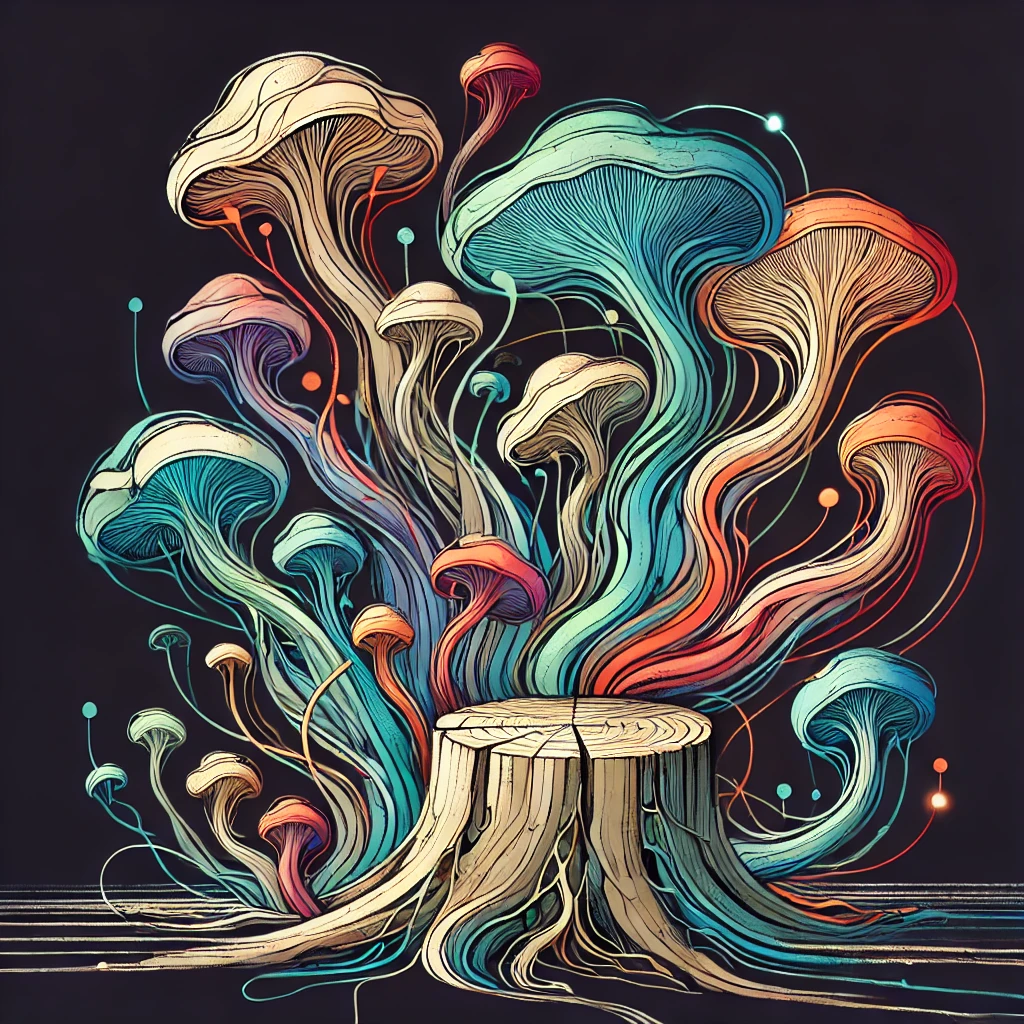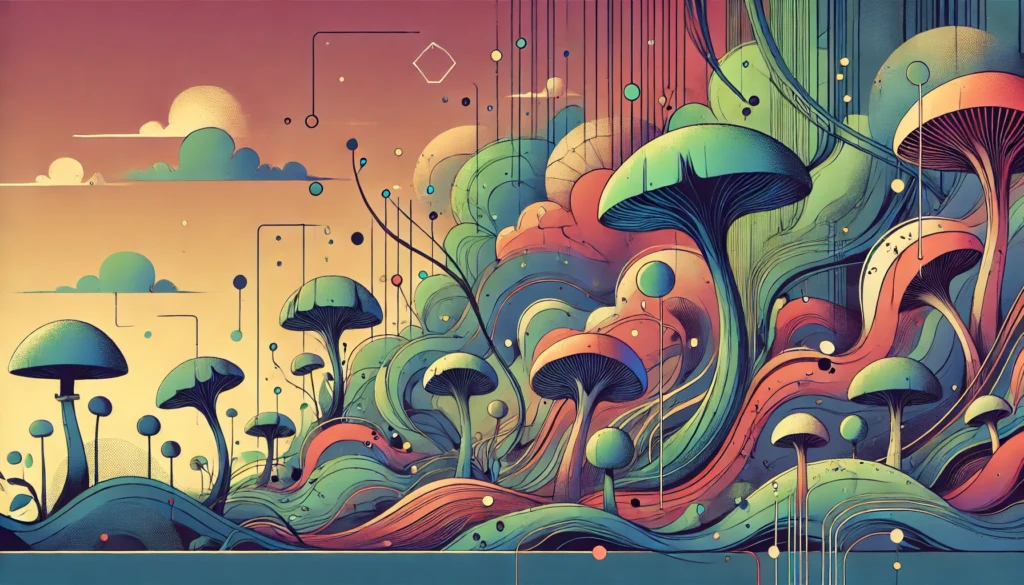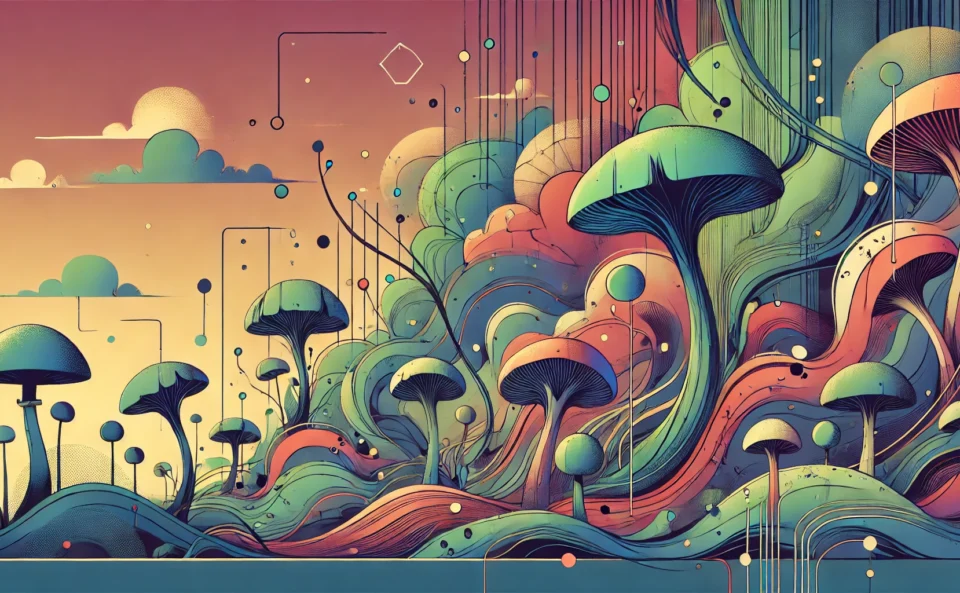I. The Mycological Internet: Where Vibes Really Come From
-
In 1998, researchers discovered that beneath the forests of Oregon, an Armillaria Ostoyae fungus had spread its mycelium over 2,385 acres, making it the largest living organism on Earth. The entire forest sat atop a vast, interconnected web of fungal tendrils, quietly orchestrating the transfer of nutrients, information, and survival strategies between trees. But from the surface, you’d never know it.
Mycelium networks are hidden, sprawling, and decentralized. We only notice them when a mushroom—a fruiting body—suddenly emerges from the forest floor. But that mushroom is just the visible symptom of an invisible, far older process beneath the soil.
Discourse works the same way.
For most of the 2010s, we assumed cultural shifts happened because of public debates, trending topics, and visible ideological struggles. We believed that Twitter fights, op-eds, and mainstream discourse were the primary mechanisms shaping society.
But what if those weren’t the drivers at all?
What if discourse is fungal?
What if the fundamental shifts—the ones that matter—aren’t happening where we can see them but are growing quietly beneath the surface, spreading through invisible tendrils, only occasionally breaking through into public view?
What happens when the digital forest floor shifts and the mushrooms start sprouting in new places?
II. The Death of Broadcast: How the Network Went Feral
McLuhan told us the medium is the message, but the first half of the 2020s has taught us that the medium is the mycelium.
The early internet functioned like a cleared field—public, open, and exposed to direct sunlight. Twitter, Facebook, and Reddit became public squares where ideas battled for dominance.
But what happens when the soil gets compacted, the nutrients depleted, and the air turns hostile?
You don’t stop growing. You move underground.
Each platform shaped discourse in distinct ways:
- X (formerly Twitter) → Encouraged high-velocity ideological warfare, where engagement rewards an idea’s most extreme, viral expressions.
- Facebook → Encouraged highly local enclaves of conspiracy, personal grievances, and neighborhood feuds.
- Reddit → Encouraged a pseudo-meritocracy, where upvote-driven filtering gives the illusion of democratic discourse while moderators act as feudal landlords.
Slowly, with each new dissatisfied user, the great migration began.
People stopped posting publicly, fighting in the sunlit clearing, and took their conversations elsewhere—into closed group chats, private servers, and spaces where ideas could spread without immediate scrutiny.
Instead of a broadcast-based model (one-to-many), the discourse runs on a mycelial model (decentralized, many-to-many, hidden until emergent).
The New Tech Stack of Discourse:
- Discord / Signal / Telegram → Fungal networks, where thought leaders cultivate high-trust relationships in semi-private conversations.
- Substack / Long-Form Blogs → The mycorrhizal filaments that connect thinkers to each other without algorithmic interference.
- Podcasts & Private Feeds → Spore dispersal mechanisms, where niche ideas quietly gain mass before going airborne.
Discourse has become post-public.
We removed the trees, and the forest floor adapted. The mycelium kept growing.

III. Stealth Influence: The Art of Being Important Without Being Seen
A funny thing happened when the public square’s importance faded:
Being visible stopped being powerful.
In the 2010s, clout came from being public. The journalist with the most prominent Twitter following, the pundit whose takes landed on cable news, the thought leader with the highest engagement.
Now, power comes from being invisible.
This is the era of covert prestige—where the most influential people aren’t the ones with the loudest voices but the ones with direct access to the right networks.
Consider Historical Parallels:
- The Renaissance → The most powerful ideas weren’t printed in town squares; they were whispered in private salons, funded by Medici patrons.
- Cold War Samizdat → The most dangerous ideas weren’t in mainstream media; they were passed hand-to-hand in typewritten pamphlets.
- The Underground Music Scenes of the 1970s → Punk didn’t start on Billboard; it festered in grimy backrooms where only insiders knew what was happening.
Today, the most consequential conversations are happening outside mainstream visibility.
They live in:
- Private Discord servers where intellectuals, investors, and artists cross-pollinate ideas before they go mainstream.
- Signal chats where VCs, political operatives, and cultural figures strategize the next decade in total privacy.
- The DMs of people who never post publicly but whose private takes quietly shape billion-dollar industries.
This matters because when an idea surfaces, it is fully formed.
By the time the public notices a shift—whether it’s DEI backlash, the resurgence of quiet-luxury conservatism, or the collapse of progressive institutional dominance—it has already been decided in the underground mycelium network.
The Vibe Shift is Post-Public.
IV. The Mycelial Shift: From Viral to Fungal Information Warfare
If the 2010s were about who controlled the public square, the 2020s are about who controls the hidden networks where ideas incubate.
We are shifting from an era of mass media dominance to an era of fungal power, where:
- The most influential figures don’t post publicly.
- The real decisions happen in invisible backchannels, untraceable to the average observer.
- The loudest voices are not the ones setting the agenda.
This doesn’t mean there won’t be big cultural moments—there will be. But they will emerge like mushrooms after rain, seemingly overnight but actually built from years of unseen growth.
So the real question is:
Who owns the mycelial networks now that the forest floor has shifted?
V. The Medium Was Always the Mycelium
The mycelium of the Pacific Northwest has existed for thousands of years, long before anyone realized it was there. The mushrooms we see in the woods are not the fungi themselves but just a fleeting, momentary manifestation of something much older, much deeper, and much more challenging to eradicate.
Most analysts still think ideas rise and fall because of visible public discourse. They assume that if something isn’t trending or being openly debated, it isn’t real.
But the significant events of the next decade—political shifts, cultural revolutions, economic realignments—won’t be driven by who wins the Twitter fight.
They will be driven by:
- Who controls the private networks of influence.
- Who has access to the real conversations happening off-grid?
- Who understands that ideas now spread underground before they erupt into public consciousness.
The tech stack changed. The viral vectors changed. The new power players aren’t making noise.
They are growing the mycelium.
And the forest is already shifting.

